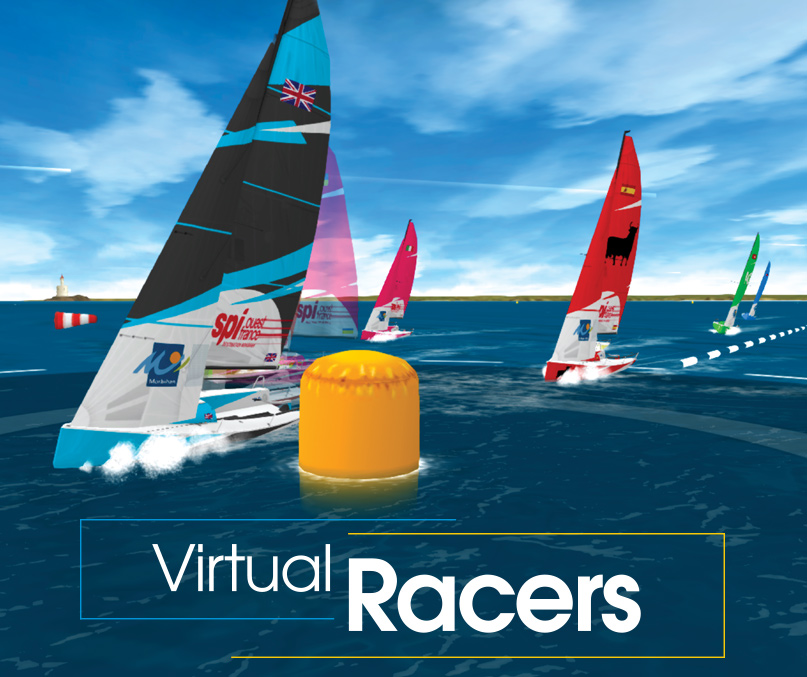
 The program is called Virtual Regatta Inshore, and with Skype and a good internet connection, anyone can race from the comfort of their own couch for free. Corinthian Yacht Club (CYC) in Seattle has a fast-growing fleet of participants, who have now been racing together since April. There is a bit of a learning curve involved, and the program has its quirks, which just adds to the fun. If you just sit back and imagine the various controls as commands to the crew, it really starts to feel real. Here’s how it works:
The program is called Virtual Regatta Inshore, and with Skype and a good internet connection, anyone can race from the comfort of their own couch for free. Corinthian Yacht Club (CYC) in Seattle has a fast-growing fleet of participants, who have now been racing together since April. There is a bit of a learning curve involved, and the program has its quirks, which just adds to the fun. If you just sit back and imagine the various controls as commands to the crew, it really starts to feel real. Here’s how it works:
You need an account with the Virtual Regatta Inshore app or website. (There is also an Offshore app by the same people). You set up a Pseudo name on the site which becomes your boat name. Once this is done, you can register your boat with CYC on the yacht club website at cycseattle.org. Just before the start of the race, you’ll receive an e-mail from CYC that has a link to the Skype chat that will be used. Inshore allows 20 boats in a race. If there are 21 boats signed up, the fleet is split and there would be a separate host and Skype call created for each fleet. The fleets are divided using a ranking system, and racers stay in the designated fleet for the entire night. Much like the premier league model, racers move up and down in the rankings depending on the race results each night.
Once on the Skype call, the host notifies the racers that the first race is “live” and an access code is shared. There is a custom race tab on the start screen for VR Inshore that you click, and a pop-up window will open with several options. At the bottom of the new window is a padlock icon, you click it and enter the access code into the field, and voila! At this point, you’ve been entered into the prestart area of the race and this is where the fun begins!
Once everyone is in the prestart area, the clock begins, and competitors have 1 minute and 15 seconds to start. After each race, scores are updated and the host sets up the next race. The host will again say the race is live, gives the access code, then you do it all over again. Most times the scores are updated on the CYC website before the next race starts! Typically, CYC does five races, with three in the offshore racer mode with TP 52 type boats, and two in a J-70. The race locations are totally random and often depend entirely on the mood of the host. Personally, I like to move to a different location each race.
Connectivity is huge, as a slow connection leads to slow reaction time to the controls. I have found running the Skype meeting and VR website on different devices is a huge help. You will at some point push the wrong button. I think everyone has accidently set their kite up wind or tacked unintentionally. There is no undo button, so when you make a mistake, just react and move on.
The rules algorithm on the app is a bit off. There does not appear to be any regard to rule 15 (acquiring right of way) and 16 (changing course) in respect to giving the other boat time to react. It is very possible for someone to tack, gybe, or acquire an overlap, and be instantly penalized. Frustrating, but again, best to just shrug it off. Guaranteed you will do the same to someone else at some point.
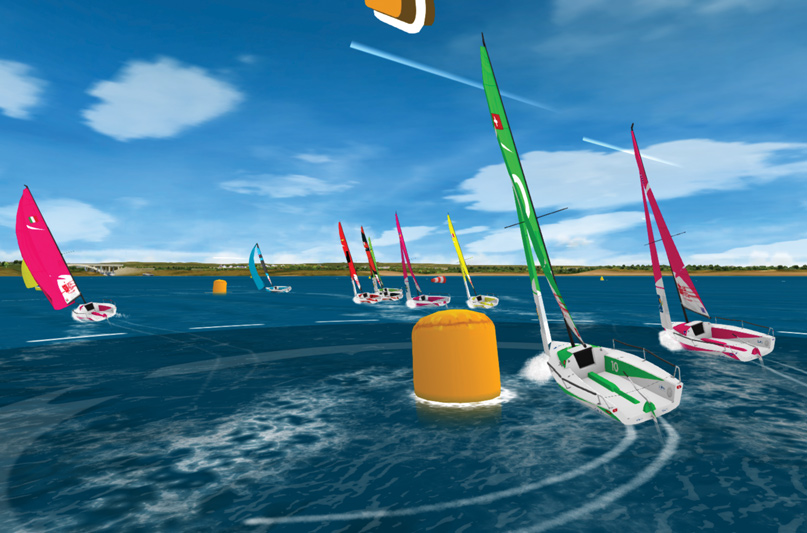
Due to these three issues, it’s important to not take it too seriously, as we’re not even racing for a pickle dish! It is all in good fun and important to keep that in mind. When the controls are slow, you push the wrong button, or you are punished unjustly, it is best to just acknowledge the system has its flaws, laugh it off, and sail on.
I also recommend purchasing some of the optional tokens. I spent about $15 to get several that should last me all season. (This is way less than my bar tab after weeknight racing on the water, so the cost is really minimal!) With the tokens, you can have access to your instruments and see the lay lines, time to start line, best VMG (velocity made good), wind shadow and wind intelligence features on all at once. Without the tokens, you only get one of these (but for free) at random in each race.
Of these instruments, most people agree that the VMG is the all-around must-have, as it’s basically an autopilot that keeps the tell tails flying and auto reacts to wind shifts. The lay lines feature will super-impose some dotted lines on the water that show about where the lay lines are to the next mark. This makes judging your approach to the marks a lot easier. The time to the start line shows a target where you will be and time to the start line at your current speed and direction.
Wind shadow will show the bad air coming off the other boats so you know if you are being blanketed or not. Wind intelligence adds some windsocks and shadowing to the course radar so you can see shifts and puffs.
In summary, virtual racing started to fill the gap felt by not being able to race. The comradery is really great, and we have a lot of fun not only racing, but being able to chat with each other during the race.
Most racers keep their mics on, so you get to hear them groaning when something goes wrong, not something you generally hear when you’re actually racing! We are also quick to apologize when we make mistakes that affect others, and this really helps to keep the environment fun and relaxing. The more seasoned players are always willing to help the newbies get up to speed, and some will even share tactics and wind changes with everyone.
There are many of us out there that have really started to enjoy virtual racing and are planning some off-season events for the winter of 2020-21. CYC is currently exploring the idea of hosting a winter VR series, and perhaps even some interclub challenge cups, such as the Lipton Cup. I expect that as long as interests in virtual racing remains high, we will continue promoting and expanding the program. We are seeing people join in who normally just crew and have never skippered their own boat. We’re also seeing sailboat cruisers who have never raced before logging in and trying out pushing the stick or turning the wheel around. Virtual racing is a thing. It’s becoming an even bigger thing as access to the real regattas are placed on hold due to COVID-19.
Lesson 1: The race timer is on the top of the screen, not the one in the middle.
In my very first race of the night, I thought I had really nailed the start. On my approach to the start, a big red count down timer started right in the middle of the screen with a target showing where I was going to be on the line. I remember thinking, “What a great feature! I wish I had this on the real boat!” The timer read “0” right when I got to the line, nailed it! A few seconds later a large, an annoying pop-up appeared declaring, “Miss Start!” That is when I realized my error. The red timer that appears in the middle of the screen during the run-up to the start is your time to the line, not the official start time.
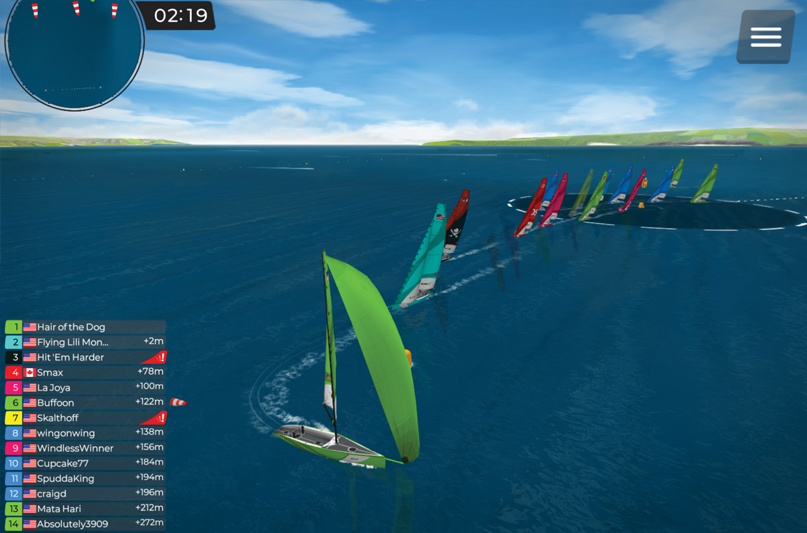
Lesson 2: You can look around.
In a VR race, I tacked to port only to be immediately T-boned by a starboard boat that was in my “blind spot.” Not exactly the actions you would expect out of a 30-year sailboat racing veteran. I did, however, learn how the penalties work. I was immediately made into a ghost ship and my sails flogged as the system made me sit there and think about what I had done for 10 seconds. It took me several more races to learn that you can zoom in and out and change the camera angle to look at what’s around you! It’s a lot easier to see to tack when you can move your head around!
Lesson 3: The steering controls can be a bit unpredictable.
It can fail to turn the boat entirely, or more annoyingly, turn it in unexpected ways. In one race, I finally discovered the “tack” button. I highly recommend using this unless you like going into irons a lot! Once I found myself coming into the first mark in second place!
Unfortunately, I was on the dreaded port lay line. I did manage to see a hole between the second and third boats coming in on starboard. “I can make that hole, and coming out in fourth is not so bad,” would be my famous last words. In my arrogance, I turned down, intending to aim for the spot. Well the loose gudgeons on my rudder caused me to turn down too far, and I promptly slammed into the third-place boat and had to do two penalty turns. After sitting in time out for 10 seconds just above the starboard lay line on port, I used the nifty tack button.
In doing so, I learned that the tack button takes you from the angle you were on one tack to the same angle on the other. As I was sailing about 90 degrees off the wind on port, I tacked and the boat immediate headed down to 90 AWA (apparent wind angle) on starboard. Unfortunately, there was a boat occupying that spot. Hmmm. This one brought my total to four penalty turns. After I sat in my well-earned third time-out, I sheeted in and promptly slammed into the boat ahead of me when a jammed main sheet failed to allow the boat to turn down as I hoped.
Two more penalty turns and I was at six total. This time I had a great view of the fleet rounding the mark as I sat in time-out. It was nice to see the entire fleet ahead of me on the downwind, makes it easy to see what’s going on around the course. I spent the rest of that race wondering if I needed to shred my Judge certificate.
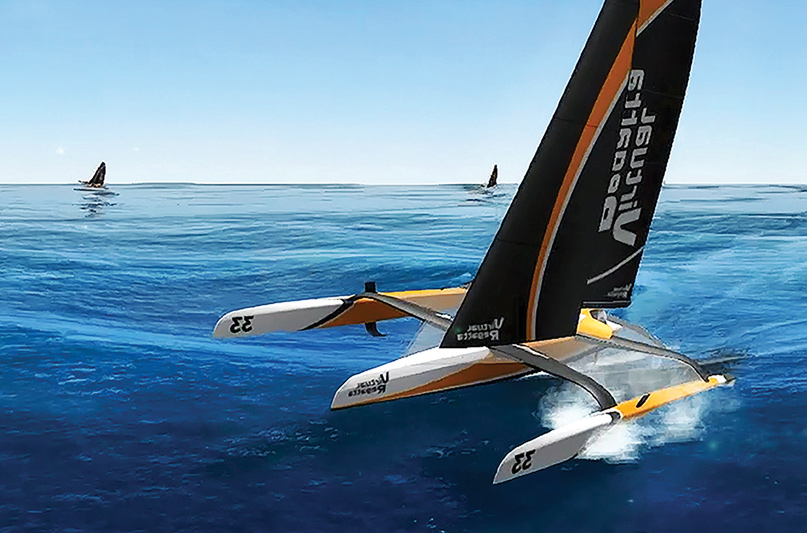
Lesson 4: Connectivity and computer speed can be a real game changer.
One night when I was playing the game, my wife was streaming an action movie, and someone else in the household thought it would be a great idea to have hundreds of opened web pages on their PC, all buffering and downloading content and ads. Wisely, the router knew to give priority to my wife. Unfortunately for me, and maybe because the router holds a grudge against me or something, it put my data at the bottom of the pile. This spotty connection can cause a delay in when commands are executed and to compound the issue, commands cannot be undone.
On more than one occasion, I would give the command to turn and nothing would happen. I would do it again, nothing. So, the frustrated three-year-old child inside me would take over and slam the rudder hard over by wailing on the turn button. A few agonizing seconds later, the connection would reestablish. But those hundreds of key strokes would still be logged, so my boat would start turning in a tight spiral of death, all the while taking out the mark and most of the fleet while I was at it!
This would infuriate the inner three-year-old child still at the helm, the tiller would be slammed the other way in order to try and stop. This would mean that once all the commands for turning to port were met (usually after a 1080), all the new commands to starboard would start and I would start spinning uncontrollably the other way.
All these needless maneuvers would put me pretty deep in the fleet, combined with the minute or so of penalties tacked on top that usually placed me solidly in the back. The good news is I had enough time to go to the fridge and get a treat to calm the inner three-year-old and transform back into a 43-year-old! I highly recommend taking the following steps: Do not run the Skype meeting and the VR program on the same machine and make sure your connectivity is not being overtaxed in the household.
Lesson 5: The crew (computer) responds to your requests no matter how stupid they are.
On many occasions while going upwind, I accidentally pushed the set/douse spinnaker button instead of the tack button. By keying in the wrong command, instead of yelling “Tacking,” my virtual skipper would yell “Hoist” which would result in the crew (computer) executing the order, no matter how much I would yell, “STOP, BELAY THAT ORDER, YOU BLOODY MORONS!” As I watched the kite and my dreams of victory go to the top of the mast while beating upwind, I had no choice but to take it. It was fun explaining on the chat why the first-place boat was suddenly putting the kite up and down and spinning in circles of frustration. All I could do is explain that my bowman needed a talking to. A fellow competitor added, “You must be playing Virtual Regatta,” a phrase that would explain so much.
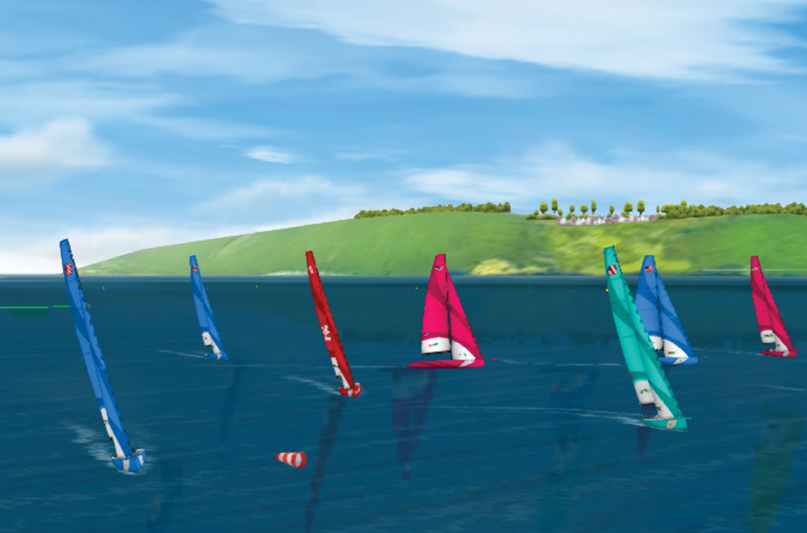
Lesson 6: The umpires on the water need some more practice.
I once I found myself in second place in a race going around the mark onto the final downwind leg and within striking distance of first place! My internal soundtrack was playing, “I know how to handle this.” The third-place boat was over 100 yards back, and I had some time to engage. I started sitting on the first-place boat’s air, keeping an eye out for the third-place boat to make sure I was not going to give up my hard-fought second. The covering was working great, the two of us played the familiar dance, and I soon found myself overlapped to windward and passing. Like a good little champion, the other boat luffed and I reacted. When we both came down again, I got greedy and narrowed the gap. I could hear the match umpires saying, “All on me” and pointing out that I had put myself there. With third place still 100 yards back, the first-place boat came at me again. This time, I was too slow to react and we collided.
I could sense the umpires grabbing the penalty flag. While waiting for my time-out to start and securing the dunce cap, I noticed the other boat went ghost and stopped. The umpires penalized the wrong boat! Knowing that was not right, I did the seaman-like thing, and started doing some penalty turns until the other boat was out of jail and free to run, then I followed them to the finish. Luckily, third place was back enough and I still earned second, but it was close. In that incident, I also learned a virtual Star boat can make two turns REALLY fast. If I had done it that quick in the real world, I might be ordering a new mast today.
I am hooked on Virtual Racing and plan on being there every night that Corinthian Yacht Club in Seattle hosts an event. Kudos to those who continually give me a spanking, Flying Lili, Hair of the Dog, Hit ‘em Hardier, I’m talking to you. Fellow sailing enthusiasts, come join us for the fun, the more the merrier. Look for me on the virtual water under the Pseudo, Cupcake77.
 Jared Hickman is a longtime member of Corinthian Yacht Club in Seattle, and Chief Judge at Whidbey Island Race Week (now Point Roberts Race Week) with a passion for sailing since he was a kid. In 2013, he competed in the Melges 24 Worlds and has also enjoyed racing his International 14 and Star. He is a World Sailing International Judge (IJ), US Sailing National Judge (NJ), and a US Sailing National Umpire (NU).
Jared Hickman is a longtime member of Corinthian Yacht Club in Seattle, and Chief Judge at Whidbey Island Race Week (now Point Roberts Race Week) with a passion for sailing since he was a kid. In 2013, he competed in the Melges 24 Worlds and has also enjoyed racing his International 14 and Star. He is a World Sailing International Judge (IJ), US Sailing National Judge (NJ), and a US Sailing National Umpire (NU).
Player Perspective
By Lek Dimarucot
It’s not the real thing, but it’s close.
Virtual Regatta Inshore is quite immersive and some elements evoke the real thing — such as the starting horn blaring, sails luffing as the boat tacks, and winches squeaking as the spinnaker is hoisted. All good stuff.
It’s not a substitute for being physically out on the water with the wind in my face, the rocking of the waves under my legs, and that reassuring feeling in my belly when the boat accelerates into a new tack. I must admit that when I first started playing, I thought it would be a way to partially experience sailing; an imperfect remedy for all the race days lost to COVID-19.
After several of weeks of playing, I’m hooked. I’ve come to really appreciate Virtual Regatta Inshore as its own unique thing. Turns out, it’s an excellent platform for learning and practicing strategy and tactics. We can see what’s going on in the entire race course: where there’s stronger breeze, and where the shifts are; and because the races are short, we can pack a weekend’s worth of racing in just one evening!
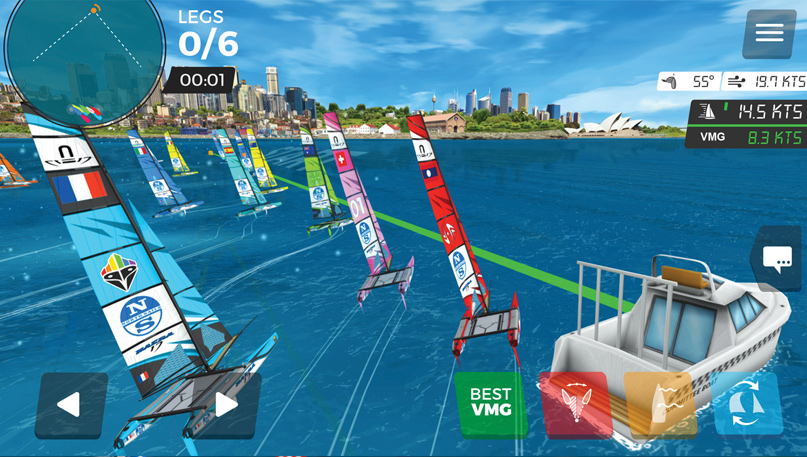
It’s also a good entry point into match racing, without the risk of physical damage to boats. When it’s paired with a video chat app, it’s a fun place to hang out with friends both near and far, and a great way to bring more sailors into racing. The game developers still have some work to do to keep the game from crashing occasionally (though that could be due to my broadband connection), to refine how racing rules are applied, and to encourage good sportsmanship. In the meantime, it’s great to see them continually working to improve the experience. For example, they’ve added more race venues, which now total 18, including three in the U.S. I expect to continue racing online even after we get back on the water.
Lek Dimarucot works for Microsoft, and has lived in the Pacific Northwest since 2005. He discovered sailboat racing through the Seattle Sailing Club, and bought a J/80 named Underdog in 2014. He is currently the fleet captain of the local J/80 class, and a member of Corinthian Yacht Club in Seattle.


